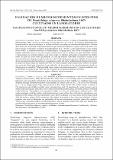Por favor, use este identificador para citar o enlazar este ítem:
https://hdl.handle.net/20.500.12958/3452| Título : | Validación de microincrementos en otolitos de Paralichthys adspersus (Steindachner, 1867) cultivado en laboratorio |
| Otros títulos : | Validation of otolith microincrements in lab-cultured Paralichthys adspersus (Steindachner, 1867) |
| Autor : | Goicochea Vigo, Carlos Carrera Santos, Lili Cota Mamani, Noemí |
| Palabras clave : | Paralichthys adspersus;Otolitos;Cultivo |
| Fecha de publicación : | 2020 |
| Editorial : | Instituto del Mar del Perú |
| Citación : | Bol Inst Mar Perú. 35(1) 2020, p. 80-87 |
| Citación : | Boletín IMARPE 35(1), 2020; |
| Resumen : | Se validó la periodicidad de formación de los microincrementos en otolitos de Paralichthys adspersus cultivado en laboratorio. A través de la inducción hormonal se obtuvieron huevos que fueron incubados en tanques cónicos de 150 L. Las larvas fueron recolectadas en bolsas de polipropileno de 9 x 19 cm y como preservante se usó alcohol etílico al 96%. La muestra inicial estuvo constituida por 110 ejemplares y solo a 59 se les extrajo los otolitos
(sagita) utilizando pinzas y un microscopio estereoscópico, fueron lavados con agua destilada, secados
y almacenados en cartones otoliteros con fondo negro. En láminas portaobjeto se montaron los otolitos
sobre una gota de cristal bond, se pulieron con una lija número 1200 hasta visualizar el núcleo y los
microincrementos, después se aplicó un abrasivo de 0,3 micras de grano para los acabados. Los recuentos
de los microincrementos (tres lecturas) se realizaron a partir del primer anillo formado después del núcleo,
se utilizó un microscopio con aumento de 400X. Se obtuvo el grado de precisión de los conteos. Se utilizó una ecuación lineal para determinar la periodicidad de formación de los microincrementos donde se relacionaron las variables: “Edad conocida versus número de microincrementos” y un test estadístico para la pendiente. Se concluye que el periodo de formación de los microincrementos es diario. ABSTRACT: In Paralichthys adspersus cultivated in the laboratory, the periodicity of formation of the microincrements in their otoliths was validated. Eggs were obtained through hormonal induction and incubated in conical tanks of 150 L. The larvae were collected in 9 x 19 cm polypropylene bags and preserved in 96% ethyl alcohol. The initial sample consisted of 110 specimens and otoliths (sagittal) were extracted from only 59 specimens by using tweezers and a stereoscopic microscope; then, they were washed with distilled water, dried, and stored in black-bottomed cardboard boxes. The otoliths were mounted in slides on a drop of bonded glass, polished with a 1200 grade sandpaper until the nucleus and microincrements were visible, then a 0.3-micron grit abrasive was applied for the finishes. The microincrement counts (three readings) were made from the first ring formed after the nucleus, using a 400X microscope. The degree of accuracy of the counts was obtained. A linear equation was used to determine the periodicity of the microincrement formation where the variables: “known age versus the number of microincrements” and a statistical test for the slope was related. It is concluded that the period of microincrement formation is daily. |
| URI : | https://hdl.handle.net/20.500.12958/3452 |
| ISBN : | 04587766 |
| Aparece en las colecciones: | Boletín 35(1), 2020 |
Ficheros en este ítem:
| Fichero | Descripción | Tamaño | Formato | |
|---|---|---|---|---|
| Boletin 35-1 articulo8.pdf | 412,33 kB | Adobe PDF |  Visualizar/Abrir |
Este ítem está sujeto a una licencia Creative Commons Licencia Creative Commons

